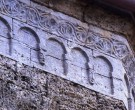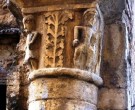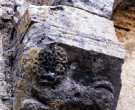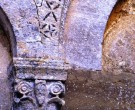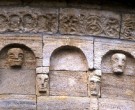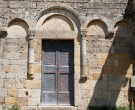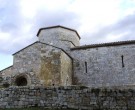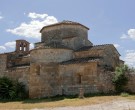> Home > What to visit > Churches and Monasteries

Abbazia di Santa Maria Assunta a Cončo Colle di Val d'Elsa
CHURCHES AND MONASTERIES
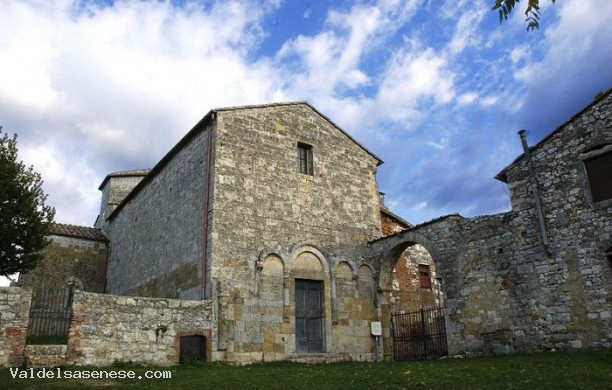
PHONE NUMBERS AND TIMES
Abbazia di Santa Maria Assunta a Cončo
Loc. Badia a Coneo 53034 Colle di Val d’Elsa
Telephone 0577.959068
Business card (vCard)
Located near the intersection of the route of the Via Francigena and the hilly road to Volterra was founded around 1000 and immediately adopted the rule benedettina.L 'aggregation reform vallombrosana occurred between 1073 and the passage 1076.Dopo order Vallombrosan it was decided to erect a new church abbey church whose construction began certainly after May 5, 1108 and was dedicated to Santa Maria in 1124 and consecrated in the presence of the bishops of Volterra, of Anagni and Acqui. The Bishop of Volterra was also the owner of the monastery and the cha know half of the twelfth century it was ruled by an abbot named Ugo [4], which was confirmed in his role as April 23, 1179 by Pope Alexander III in 1195 and the Abbot called Ildebrando.Nel 1254 to repay debts incurred by the bishop of Volterra against the Sienese bankers Abbey Conèo was forced to pledge its assets to the latter but despite this the end of the thirteenth century the abbey rents were large fully comparable to other rich monasteries valdelsani.Tra the fourteenth and fifteenth centuries, the abbey began to decline and was given in commendam but it was a great choice, in 1576, the old abbey became a parish on which they depended for 30 families abitanti.Gli about 150 inhabitants of the parish of Conèo were steadily increasing so that by the mid-eighteenth century it was considered necessary to carry out modification work that affected both the inside and the outside. The church was completely restored between 1920 and 1922, on this occasion with the economic contribution of the town of Colle Baroque additions were all removed and the building was restored to the Romanesque style.
The building of the church, consisting of a rectangular nave with transept apse vaulted with a dome on the cruise.
The facade has a portal architrave with a round arch with the ring decorated with rosettes and cord plugged into a fake tunnel roof consists of five arches resting on columns with decorated capitals concluded with anthropomorphic figures and brackets carved with animal figures. At the edge of the facade there are two half ended with capitals ungulates. The order of the facade has been profoundly altered by the recent restoration since you first opened a mullioned window topped by a belfry. From the outside, the only side clearly visible is the northern one in which there are three lancet windows with archway in two colors placed at regular intervals. Up the side wall is crowned by a series of arches decorated with palm leaves monolithic supported by corbels decorated with anthropomorphic figures which male heads connected by garlands, above which stands the frame decorated with leaves and racemes. In the left transept, which was leaning against unspecified time in a building now in ruins, has a lancet arch with columns with carved rosettes bicromico sill and framed between two pilasters, the lancet is very similar to those found in the church of Cellole and in the church of Cedda. The area of the forum looks very similar to that of the cathedral of Sovana or other abbeys Maremma and is characterized by the volume of the central and the lower structure that contains the side as in the parish of Mensano. The culmination of the curve of the apse is similar to that of the sides but here it is enriched by a series of heads placed under the bows and rosettes and interlacing viminei in the frame. In correspondence of each of the three aisles are opened as many monofore with archivolt monolithic dual splay. The wall of the lower part of the apse is made to drafts of stone and probably belongs to an existing building. The entire building is dominated by the octagonal lantern that contains the dome covered with a pyramidal roof, has a single opening to the eye very close and is decorated with foliage and arches resting on small shelves anthropomorphic alternate columns.
The interior has a Latin cross on the typical model of the churches Vallombrosan and I cause this is similar to that of the Coltibuono Abbey and the Abbey Berardenga The gap between the classroom and the chancel with transepts and separated by an arch resting on half-hanging motif typical of the churches Vallombrosan. The area of the sanctuary is divided into three distinct sections: the two side sections formed by the arms of the transepts having a barrel vault and apse deeply recessed in the wall bag, and the section formed by the cruise, separated from the aisles by ricassati arches resting on columns, ended by a dome into wedges. The church hall is covered with trusses in plain sight. On the right side there is the portal that gives access to the monastery and you monofore very similar but offset from those on the left. Leaning against the side walls there are half columns that have capitals with abaci very prominent as in Pieve di Scola. Once in the church the first two that you will encounter are those that decorate the semi in the middle of the aisle and both show two figures of praying or perhaps caryatids divided by a column and dressed in tunics of different shapes, the figures on the left represent two monks threatened by a snake. The capitals places to support the central arch are decorated with foliage but the pulvini decorated with foliage and flowers with five points as the schedules of the parish of Coiano. All other capiteli have a simple decoration with foliage.
STAY NEARBY
VILLA BELVEDERE
COLLE DI VAL D'ELSA
...LA VECCHIA CARTIERA
COLLE DI VAL D'ELSA
...RELAIS DELLA ROVERE
COLLE DI VAL D'ELSA
...DINING & ENTERTAINMENT NEARBY
Teatro dei Varii
COLLE DI VAL D'ELSA
Posto quasi di fronte al Palazzo del Comune o dei Priori ha origini antichissime: prima os...Cinema Teatro Sant'Agostino
COLLE DI VAL D'ELSA
...Cinema Teatro Del Popolo
COLLE DI VAL D'ELSA
From: Notes on the theatrical tradition in Colle di Marcello Braccagni In: Miscellaneous...



